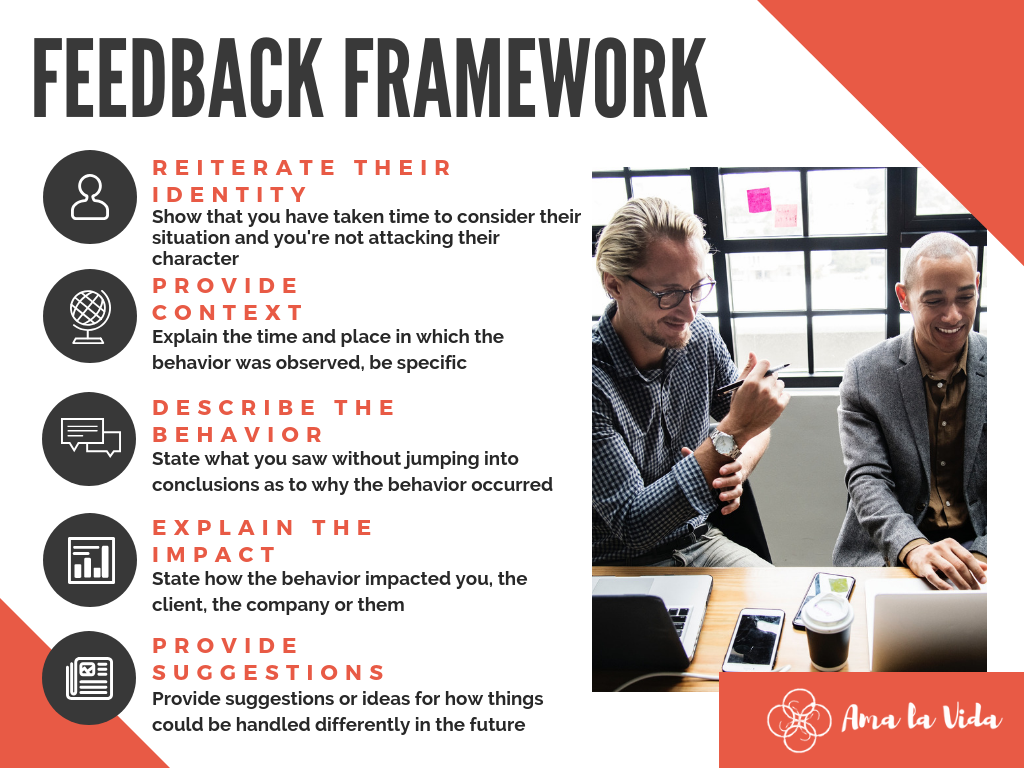How To Give Virtual Feedback Effectively
Entrepreneurship, Leadership Coaching, Work Life Integration

It feels like we were making great strides with having one on one feedback conversations – both positive and constructive. We made it a point to have ad-hoc conversations when walking down the hall. But now that has changed. With a virtual working environment, we don’t have the same ad-hoc opportunities. We are being pulled in many directions and providing feedback isn’t always top of mind. Contrary to our actions, providing feedback and reinforcement right now is one of the best ways to continue to engage your team and help develop them. If providing feedback before was difficult for you, it’s even more challenging in a virtual environment. There are ways to provide virtual feedback and do it effectively. Here’s how:
Create a goal to provide feedback.
If you aren’t regularly providing feedback to your employees, first start with creating a goal. Perhaps that goal is providing constructive feedback one time/week and positive feedback two times a week. You’ll notice positive feedback is easier to give than constructive feedback. The intention here is to practice. Once you have successfully taken these steps to provide feedback, then challenge yourself after three weeks of consistent practice to increase the frequency. What you’ll learn is that the more you practice, the easier it gets. Slowly it will become so intuitive that you won’t have to sweat about giving feedback.
Learn a feedback framework.
If you’re currently using the compliment sandwich or what I call the shit sandwich feedback framework, stop. The shit sandwich is giving positive feedback, squeezing in some constructive feedback and then closing it with a positive feedback. This type of feedback format isn’t effective. In fact, it dilutes the message and confuses the recipient. Here is Ama La Vida’s feedback framework. Learning a framework is the first step in preparing for your feedback. While this is not a linear framework; however, it’s important to walk through each point when giving both positive and constructive feedback.

Collect data.
If your team members work cross-functionally, reach out to those they work with and ask them what your team member is doing well and can be improved upon. These will serve as additional data points for you to share with your team members. It will also help you have additional insight in case there are conflicting points of view from your team members.
Prepare for your virtual feedback conversation.
Write down your main talking points. Incorporate the feedback framework and make sure there is only one key message. Do not try to integrate five different points in one conversation. Otherwise, the recipient will leave confused and not know what to focus on. As you prepare your feedback, ask yourself: Does my message include empathy? Have I tested my assumptions? Have I created the message with positive intent? Then practice your delivery in the mirror or with a peer. It’s one thing to think about your conversation; it’s another to practice out loud.
Schedule time with your colleague and use video.
Ask your direct report if it’s a good time to share feedback. It’s important to get permission as this allows for both parties to be mentally prepared. It’s also important that you both have video on so that you can read body language. Start the conversation by building rapport and connection. Then go into your feedback framework as practiced. When you are delivering the feedback, be sure to do so in the other person’s language. For example, if the recipient is very analytical, they are going to need to know who, what, where, when and why. If the individual is a quick talker, they’ll need you to get to the point quickly so that they can understand what the takeaway is. Be sure to adjust your communication style to the needs of the recipient.
Use slack/email for informal communication and feedback.
Not every piece of feedback has to be scheduled formally. If a colleague wrote a really good email, reply back and let her know what you liked about the email. There is no need to be overly formal about feedback except for when a conversation is required. This is especially true for positive virtual feedback. Send a quick note when someone is doing something particularly well, explain what you like about what they have done and you can reinforce it again when you have your 1:1 meeting.
Hold yourself and your team accountable.
It’s important now more than ever to have closer relationships with your team. If you were doing 1:1s every month, it might be time to shift to bi-weekly until the team has started to find their working groove again. Be more available to your team. Hold everyone accountable to sharing feedback – downward, laterally and upward. Because you can’t physically see your colleagues’ faces, you can’t see if they are stressed or upset or confused. This is the time to over-communicate. Have daily huddles as a team if needed. Create an open space to go through what’s working and not working. Discuss how everyone is still learning and growing. Solicit feedback if you’re not getting it – the more you can know about what someone needs, the easier it’ll be to solve the problem.
Closely monitor metrics to assess performance.
Sometimes constructive feedback is a response to an event that’s occurred. That’s reactive feedback. While we can’t be proactive about all feedback, it’s imperative in a remote work environment that as a leader, you keep a close eye on your metrics. It means doing an audit of your team members’ metrics and making sure things are on track. It might be difficult for your team members to ask for help – they might feel overwhelmed or ashamed or stressed. This is the time for you to look for the warning signs. If you find any, quickly set up a meeting over video and curiously inquire what is going on. This might not be the time to give feedback; rather, it’s an opportunity for you to learn what your team needs and accordingly provide the proper guidance.

Yes, it is a bit difficult to provide feedback when you may not be in every meeting or able to be in person. But that doesn’t mean that there aren’t ample opportunities to do so. To provide feedback is to take a vested interest in your team. This means staying engaged with the team and finding growth opportunities. In return, you’ll find your team working better and being more engaged.


